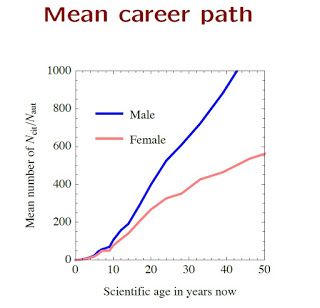A frank look at gender inequality in science
I just read a fantastic blog post discussing gender inequality in science by Sabine Hossenfelder, a theoretical physicist, author, and Research Fellow at the Frankfurt Institute for Advanced Studies. Written partly in reaction to the recent Strumia debacle, she presents a frank summary of the issue of women’s representation in science, and physics especially.
It’s a short and succinct read, and her thoughts align quite well with my own attitudes. I highly recommend giving it a look: “Yes, women in science still have a disadvantage.“
In another recent blog post, she directly tackles one of the controversial figures in Alessandro Strumia’s infamous presentation at a CERN event to discuss gender representation in high energy physics. He presents data that suggests women garner fewer citations as their careers progress. (He uses this as evidence that they are sub par researchers.) Here’s the figure:

Illustrating that good data can be badly misinterpreted in the hands of–ahem–a sub par researcher, Hossenfelder succinctly shows how Strumia mishandled his analysis. This drop off in citations can be completely accounted for by the known “leaky pipeline” problem–that women leave careers in physics at a higher rate than men. (Someone who leaves the field and ceases to publish will naturally see their citation rate fall.) Accounting for active researchers only, Hossenfelder finds no gender difference:

Check out the blog post for more details of the analysis.